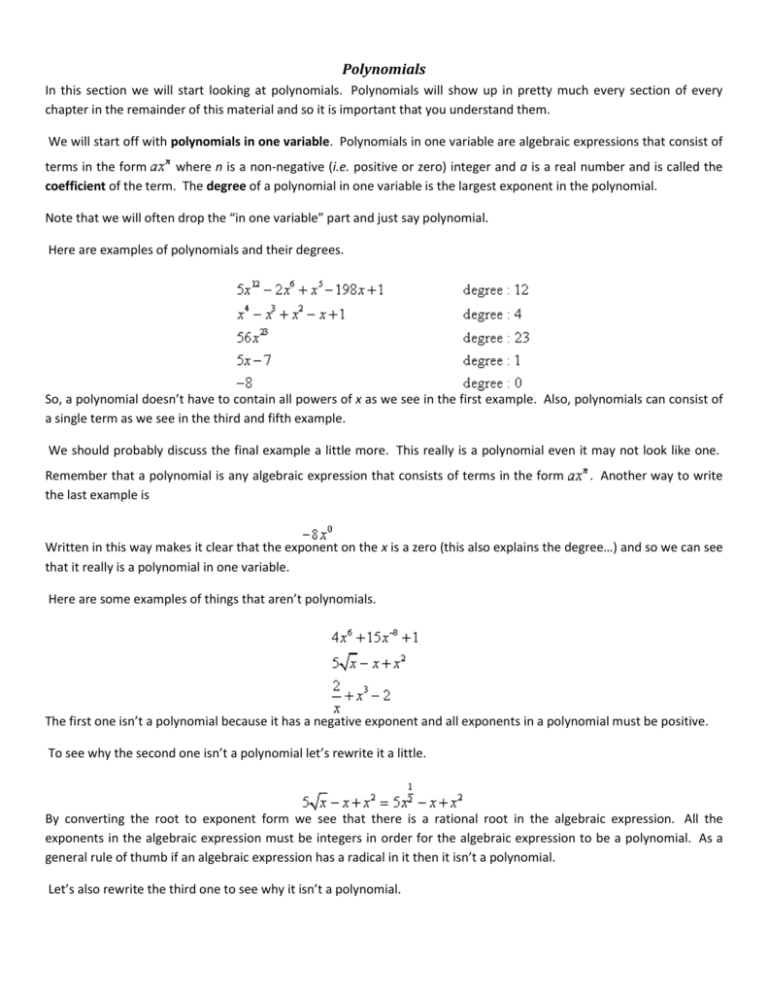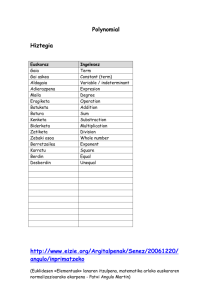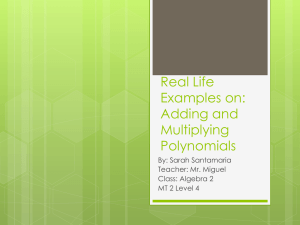Polynomials - mathatwestern
advertisement

Polynomials In this section we will start looking at polynomials. Polynomials will show up in pretty much every section of every chapter in the remainder of this material and so it is important that you understand them. We will start off with polynomials in one variable. Polynomials in one variable are algebraic expressions that consist of terms in the form where n is a non-negative (i.e. positive or zero) integer and a is a real number and is called the coefficient of the term. The degree of a polynomial in one variable is the largest exponent in the polynomial. Note that we will often drop the “in one variable” part and just say polynomial. Here are examples of polynomials and their degrees. So, a polynomial doesn’t have to contain all powers of x as we see in the first example. Also, polynomials can consist of a single term as we see in the third and fifth example. We should probably discuss the final example a little more. This really is a polynomial even it may not look like one. Remember that a polynomial is any algebraic expression that consists of terms in the form the last example is . Another way to write Written in this way makes it clear that the exponent on the x is a zero (this also explains the degree…) and so we can see that it really is a polynomial in one variable. Here are some examples of things that aren’t polynomials. The first one isn’t a polynomial because it has a negative exponent and all exponents in a polynomial must be positive. To see why the second one isn’t a polynomial let’s rewrite it a little. By converting the root to exponent form we see that there is a rational root in the algebraic expression. All the exponents in the algebraic expression must be integers in order for the algebraic expression to be a polynomial. As a general rule of thumb if an algebraic expression has a radical in it then it isn’t a polynomial. Let’s also rewrite the third one to see why it isn’t a polynomial. So, this algebraic expression really has a negative exponent in it and we know that isn’t allowed. Another rule of thumb is if there are any variables in the denominator of a fraction then the algebraic expression isn’t a polynomial. Note that this doesn’t mean that radicals and fractions aren’t allowed in polynomials. They just can’t involve the variables. For instance, the following is a polynomial There are lots of radicals and fractions in this algebraic expression, but the denominators of the fractions are only numbers and the radicands of each radical are only a numbers. Each x in the algebraic expression appears in the numerator and the exponent is a positive (or zero) integer. Therefore this is a polynomial. Next, let’s take a quick look at polynomials in two variables. Polynomials in two variables are algebraic expressions consisting of terms in the form . The degree of each term in a polynomial in two variables is the sum of the exponents in each term and the degree of the polynomial is the largest such sum. Here are some examples of polynomials in two variables and their degrees. In these kinds of polynomials not every term needs to have both x’s and y’s in them, in fact as we see in the last example they don’t need to have any terms that contain both x’s and y’s. Also, the degree of the polynomial may come from terms involving only one variable. Note as well that multiple terms may have the same degree. We can also talk about polynomials in three variables, or four variables or as many variables as we need. The vast majority of the polynomials that we’ll see in this course are polynomials in one variable and so most of the examples in the remainder of this section will be polynomials in one variable. Next we need to get some terminology out of the way. A monomial is a polynomial that consists of exactly one term. A binomial is a polynomial that consists of exactly two terms. Finally, a trinomial is a polynomial that consists of exactly three terms. We will use these terms off and on so you should probably be at least somewhat familiar with them. Now we need to talk about adding, subtracting and multiplying polynomials. You’ll note that we left out division of polynomials. That will be discussed in a later section where we will use division of polynomials quite often. Before actually starting this discussion we need to recall the distributive law. This will be used repeatedly in the remainder of this section. Here is the distributive law. We will start with adding and subtracting polynomials. This is probably best done with a couple of examples. Example 1 Perform the indicated operation for each of the following. (a) Add to (b) Subtract . from . Solution (a) The first thing that we should do is actually write down the operation that we are being asked to do. In this case the parenthesis are not required since are adding the two polynomials. They are there simply to make clear the operation that we are performing. To add two polynomials all that we do is combine like terms. This means that for each term with the same exponent we will add or subtract the coefficient of that term. In this case this is, (b) Subtract from . Again, let’s write down the operation we are doing here. We will also need to be very careful with the order that we write things down in. Here is the operation This time the parentheses around the second term are absolutely required. We are subtracting the whole polynomial and the parenthesis must be there to make sure we are in fact subtracting the whole polynomial. In doing the subtraction the first thing that we’ll do is distribute the minus sign through the parenthesis. This means that we will change the sign on every term in the second polynomial. Note that all we are really doing here is multiplying a “-1” through the second polynomial using the distributive law. After distributing the minus through the parenthesis we again combine like terms. Here is the work for this problem. Note that sometimes a term will completely drop out after combing like terms as the x did here. This will happen on occasion so don’t get excited about it when it does happen. Now let’s move onto multiplying polynomials. Again, it’s best to do these in an example. Example 2 Multiply each of the following. (a) b) (c) (d) (e) ] ] Solution (a) This one is nothing more than a quick application of the distributive law. (b) This one will use the FOIL method for multiplying these two binomials. Recall that the FOIL method will only work when multiplying two binomials. If either of the polynomials isn’t a binomial then the FOIL method won’t work. Also note that all we are really doing here is multiplying every term in the second polynomial by every term in the first polynomial. The FOIL acronym is simply a convenient way to remember this. (c) Again we will just FOIL this one out. (d) We can still FOIL binomials that involve more than one variable so don’t get excited about these kinds of problems when they arise. (e) In this case the FOIL method won’t work since the second polynomial isn’t a binomial. Recall however that the FOIL acronym was just a way to remember that we multiply every term in the second polynomial by every term in the first polynomial. That is all that we need to do here. Let’s work another set of examples that will illustrate some nice formulas for some special products. We will give the formulas after the example. Example 3 Multiply each of the following. (a) (b) (c) (d) Solution (a) We can use FOIL on this one so let’s do that. In this case the middle terms drop out. (b) Now recall that . Squaring with polynomials works the same way. So in this case we have, (c) This one is nearly identical to the previous part. (d) This part is here to remind us that we need to be careful with coefficients. When we’ve got a coefficient we MUST do the exponentiation first and then multiply the coefficient You can only multiply a coefficient through a set of parenthesis if there is an exponent of “1” on the parenthesis. If there is any other exponent then you CAN’T multiply the coefficient through the parenthesis. Just to illustrate the point. This is clearly not the same as the correct answer so be careful! The parts of this example all use one of the following special products. Be careful to not make the following mistakes! These are very common mistakes that students often make when they first start learning how to multiply polynomials.








